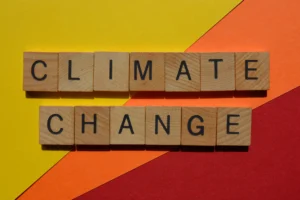It’s getting harder to ignore the impact of climate change on currency markets. It used to be that natural disasters made headlines for their devastation, but now they’re just as likely to cause massive ripples in the forex world. Floods, wildfires, hurricanes—these events don’t just damage property and claim lives. They shake economies, send investors scrambling, and move currency pairs in ways that can leave even seasoned traders surprised.
If you’re trading forex in 2025 and beyond, you can’t afford to overlook how climate risks play out in the currency market. This isn’t just about one-off shocks, either. The economic impact of natural disasters and the longer grind of climate change are reshaping how traders, investors, and even central banks think about risk. Let’s break down why this new reality matters and how climate change and FX markets are more deeply linked than most people realise.
Climate Change Hits Currency Markets
The relationship between climate and currency was not always a major consideration. A decade ago, traders focused mainly on central bank policies, interest rates, or geopolitical events. But the economic impact of natural disasters and new climate risks has forced a shift in thinking. Severe droughts in Australia, flooding in Germany, hurricanes in the US, and typhoons in Asia have made headlines. Yet, their real effects go far beyond the news—they directly shape the economic outlook for entire regions.
Sudden weather events often cause sharp swings in national currencies. At the same time, the slow-burning effects of climate change can erode economic competitiveness over years. This double effect means the impact of climate change on currency markets is both immediate and lasting.
Natural Disasters Impact on Currencies
When a major natural disaster strikes, the first market reaction is almost always negative. Traders expect short-term economic loss, government spending surges, and capital outflows. For example, the Japanese yen dropped sharply after the 2011 earthquake and tsunami. Similarly, the US dollar faced volatility after Hurricane Katrina, as investors braced for a costly recovery.
Natural disasters and currency volatility now go hand in hand. Countries that rely heavily on agriculture or tourism are especially vulnerable. If a cyclone wipes out crops in India or flooding destroys tourism infrastructure in Thailand, the economic impact of natural disasters quickly translates to a weaker currency. These events force central banks and policymakers to act fast, sometimes intervening in currency markets or adjusting fiscal policy to stabilise the situation.
Examples:
- In 2022, historic floods in Pakistan severely damaged crops and infrastructure, leading to currency depreciation.
- Australia’s bushfires and droughts repeatedly hit exports, making the Australian dollar more sensitive to climate risk.
- Hurricanes in the Caribbean disrupt tourism, resulting in ongoing currency volatility for smaller island economies.
Long-Term Climate Change and FX Markets
The long-term impact of climate change on currency markets is even more complex. While natural disasters trigger immediate reactions, climate change creates ongoing economic challenges. Countries with large coastal populations face threats from rising sea levels. Others must adapt to hotter temperatures, water shortages, or crop failures.
Climate change and FX markets are now intertwined through several mechanisms:
- Chronic weather instability affects agricultural yields and export revenues.
- Long-term infrastructure damage increases public debt.
- Migration and demographic changes can shift the economic structure of entire nations.
Investors closely monitor how governments respond. Countries with strong climate adaptation strategies and resilient infrastructure may retain market confidence. Others, perceived as unprepared or at high risk, may see their currencies steadily weaken. For example, the economic impact of natural disasters has become a central issue for emerging markets, where disaster recovery costs can be much higher relative to GDP.
Climate Risk in Forex Trading
Today, climate risk in forex trading is no longer a niche topic. Both institutional investors and retail traders pay close attention to climate change and FX markets when making trading decisions. There are several reasons for this shift:
- Financial institutions use climate risk models to assess country risk.
- Rating agencies include environmental risks when rating sovereign debt.
- Central banks incorporate climate scenarios in policy forecasts.
Traders now ask: How vulnerable is this economy to the next flood, heatwave, or drought? What impact could another record-breaking hurricane have on fiscal health and currency stability? This forward-looking mindset means that the impact of climate change on currency markets is factored into pricing even before disasters hit.
Forex brokers and data providers have responded by offering new climate risk analytics tools. These help traders anticipate how sudden weather events might impact currency pairs, especially for countries with high climate exposure. The economic impact of natural disasters is tracked in real time, often sparking rapid market moves and new trading opportunities.
The Changing Role of Central Banks and Policymakers
Central banks have a growing role in managing the impact of climate change on currency markets. Their approach includes:
- Integrating climate risk into financial stability reports.
- Supporting green finance initiatives, like green bonds or climate-linked asset purchases.
- Providing emergency liquidity after major disasters to stabilise local currencies.
When the economic impact of natural disasters is severe, central banks may intervene directly in the forex market to prevent panic-driven declines. For example, after major typhoons or earthquakes, Asian central banks have often acted to smooth currency volatility. The Bank of England and European Central Bank have also issued climate stress test reports, signalling that climate risk in forex trading is part of their policy framework.
Additionally, government policies around carbon pricing, renewable energy, and climate adaptation can affect currency values. Countries leading in climate action may become more attractive for long-term investment, supporting currency strength. Conversely, nations lagging behind risk being labelled high-risk in the eyes of global investors.
How Insurance, Reinsurance, and Risk Management Affect Currency Trends
The insurance and reinsurance industry plays a crucial but sometimes overlooked role in currency stability. After a natural disaster, insurance payouts often involve large transfers of funds across borders. This can impact currency demand and supply, especially for countries that rely heavily on international reinsurance markets.
For instance, after Hurricane Maria hit Puerto Rico, significant funds flowed into the region for recovery, impacting short-term currency movements. Similarly, after the 2011 earthquake in Japan, global reinsurers sold assets and adjusted currency exposures, influencing yen volatility.
Companies involved in global trade now use advanced risk management tools to hedge against both climate risk and currency risk. Forward contracts, options, and insurance products are all part of a modern forex risk strategy. As the economic impact of natural disasters becomes more frequent, demand for these financial products is rising.
Case Studies
Australia: The Australian dollar has repeatedly responded to bushfires, droughts, and floods. During periods of extreme weather, the currency often weakens due to lost exports and costly recovery efforts. Conversely, swift government action and climate adaptation have sometimes helped the currency recover faster.
India: The rupee is sensitive to monsoon seasons. Weak monsoons lead to poor harvests and higher food imports, putting pressure on the rupee. The economic impact of natural disasters is also seen when cyclones damage crops and infrastructure.
Caribbean Nations: Small island economies face ongoing climate threats from hurricanes. The resulting currency volatility is a major challenge, with many nations relying on external aid and financial support for disaster recovery.
Japan: The 2011 earthquake and tsunami offer a clear example of how quickly a major disaster can affect currency markets. The yen initially fell, but strong inflows for reconstruction later drove the currency higher, showing the complex and dynamic nature of these events.
Europe: Flooding in Germany and the Netherlands has increased awareness of climate risk in forex trading. The euro sometimes faces pressure when markets price in the costs of disaster recovery and future climate adaptation.
The Rise of Sustainable Finance and Green Currencies
A major trend reshaping the impact of climate change on currency markets is the growth of sustainable finance. Investors are increasingly looking for “green” assets, such as green bonds or stocks in renewable energy companies. Countries that lead in sustainability are beginning to see stronger currency performance, as global capital seeks safe and forward-thinking investment destinations.
Sustainable finance is also driving innovation in how currencies are evaluated. Some analysts have started to propose “green currency indexes” that weigh currencies based on environmental policy and climate resilience. This approach reflects the new reality that climate change and FX markets are deeply interconnected.
Governments and central banks are also exploring the use of green finance tools to build resilience and attract capital. The European Union, for example, has issued large amounts of green bonds to fund climate adaptation and infrastructure projects. These efforts not only help reduce climate risk but can also support long-term currency stability.
Climate Change and FX Markets
As the world confronts more frequent and severe climate challenges, traders and investors must adapt. The impact of climate change on currency markets is now a permanent feature of the global financial system. Smart market participants are investing in research, monitoring new risk indicators, and incorporating climate data into every decision.
Some key takeaways for traders and investors include:
- Monitor real-time data on weather events and climate risk.
- Understand the economic impact of natural disasters on your chosen markets.
- Use risk management tools to hedge against currency swings linked to climate events.
- Pay attention to government policy on climate adaptation and sustainable finance.
Looking ahead, the currencies of countries that embrace sustainability and build climate resilience will likely see stronger, more stable performance. Those that fail to act face higher risk and greater volatility.
Conclusion
The impact of climate change on currency markets is no longer just a theory. It is a daily reality for anyone involved in forex trading or international investing. From immediate shocks caused by natural disasters to the ongoing risks of a warming world, climate risk in forex trading will only increase in the years ahead.
Market participants who ignore this trend do so at their own peril. By understanding and adapting to climate change and FX markets, traders can stay ahead of the curve and turn a global challenge into a new source of insight and opportunity.
Read here to learn more about “Forex Trading and International Travel: Trade Anywhere, Anytime“.

I’m Chaitali Sethi — a seasoned financial writer and strategist specializing in Forex trading, market behavior, and trader psychology. With a deep understanding of global markets and economic trends, I simplify complex financial concepts into clear, actionable insights that empower traders at every level. Whether it’s dissecting winning strategies, breaking down market sentiment, or helping traders build the right mindset, my content bridges the gap between information and implementation.




